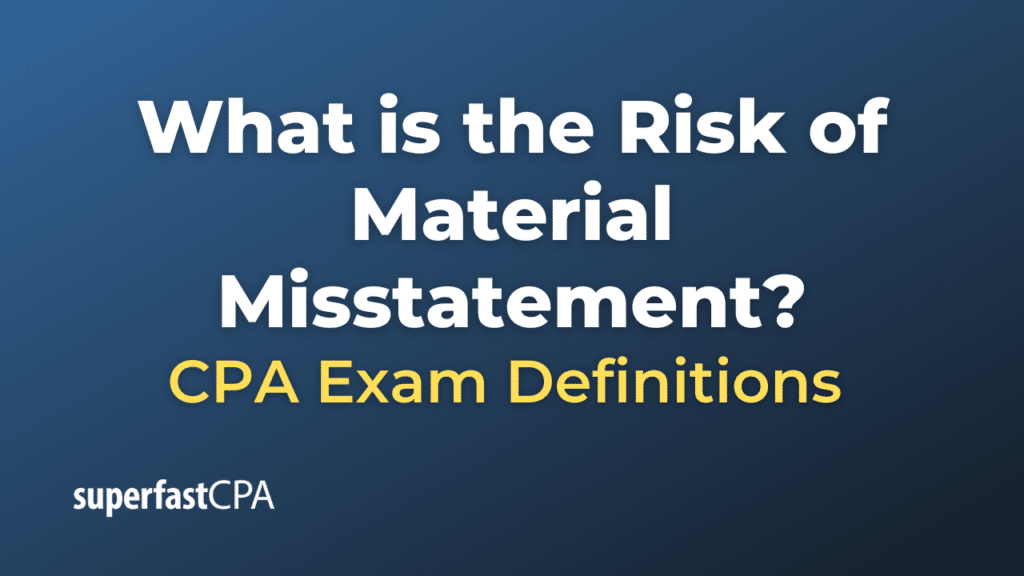Risk of Material Misstatement
The risk of material misstatement (RMM) pertains to the risk that the financial statements are materially misstated prior to the audit. This risk is intrinsic to the financial statements themselves and exists regardless of whether the financial statements are audited. The concept is fundamental in auditing because it helps auditors plan and conduct their audit procedures effectively.
The risk of material misstatement is typically divided into two main components:
- Inherent Risk (IR): This is the susceptibility of an assertion (about a class of transaction, account balance, or disclosure) to a misstatement that could be material, either individually or when aggregated with other misstatements, assuming there are no related controls. Factors contributing to inherent risk could include the complexity of the transaction, the amount of human judgment involved, or factors related to the industry or external environment.
- Control Risk (CR): This represents the risk that a misstatement that could occur in an assertion will not be prevented, or detected and corrected, on a timely basis by the entity’s internal control. If a company has weak internal controls, the control risk will be higher.
The formula that represents this relationship is:
RMM = IR × CR
To determine the extent of substantive procedures (procedures to detect material misstatements in the financial statements), auditors assess the RMM. If the RMM is high, auditors will typically perform more substantive testing. Conversely, if the RMM is low (perhaps due to strong internal controls), auditors might reduce the extent of substantive testing.
It’s important to note that while auditors can assess and adjust their audit procedures based on control risk, they cannot change the inherent risk or control risk themselves, as these are intrinsic to the entity and its environment.
In conclusion, understanding and assessing the risk of material misstatement is essential for auditors because it informs how and where they deploy their resources and efforts during the audit to provide reasonable assurance that the financial statements are free from material misstatement.
Example of the Risk of Material Misstatement
Let’s illustrate the risk of material misstatement (RMM) through a hypothetical scenario:
Company: Fruitful Ventures, a company that imports and exports exotic fruits.
Inherent Risk (IR):
- Complex Transactions: Fruitful Ventures deals with international suppliers, leading to transactions in multiple currencies. Fluctuating exchange rates can make these transactions complex.
- Judgment Areas: Estimating the value of perishable fruit inventory is challenging due to its short shelf life. It involves considerable judgment in terms of spoilage rates and market demand.
- Industry Factors: The exotic fruit market is influenced by various external factors such as weather conditions in supplier countries, international trade tariffs, and global transportation disruptions.
Given the above factors, the inherent risk for Fruitful Ventures might be assessed as high by the auditor.
Control Risk (CR):
- Internal Controls: Fruitful Ventures recently implemented a new IT system to track inventory. However, staff training on this new system has been minimal, leading to occasional errors in inventory records.
- Reconciliation Issues: The finance team has been experiencing difficulties reconciling bank statements due to the complexities of multiple currency transactions, and there have been instances of delayed supplier payments.
Considering these control weaknesses, the auditor might assess the control risk as high.
Determination of RMM:
Given that both inherent risk and control risk are assessed as high, the risk of material misstatement (RMM) would also be high.
RMM = High IR × High CR = High RMM
Audit Implication:
With a high RMM, the auditor would likely decide to perform more extensive substantive audit procedures. This could involve:
- Detailed testing of a larger sample of inventory items and international transactions.
- Engaging experts to evaluate the inventory’s perishability rate.
- In-depth evaluation and testing of the new IT system.
- Closer scrutiny of bank reconciliations and foreign exchange transactions.
This example underscores the importance of assessing both inherent and control risks. Based on their combined effect (RMM), the auditor tailors the nature, timing, and extent of audit procedures to provide reasonable assurance that material misstatements will be detected.













